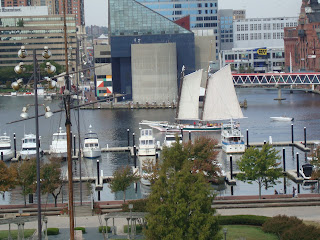Uncle Jack and Mrs. U.J. have been taking advantage of a spate of perfect fall weather to explore some parts of Charm City that have eluded them until now. Even though they have lived in Baltimore for almost two years now they realize they have hardly begun to to get acquainted with this fascinating city. With the help of a growing library of books about Baltimore, past and present, they are learning more about the its history and at the same time scoping out future walking trips. They will be spending the next couple of weeks in Nags Head but stay tuned for further adventures in the Monumental City when they return.
Union Square, a once-lovely neighborhood a few blocks west of downtown, was one of our recent destinations, primarily because it was for most of his life the home of Henry L. Mencken , the Sage of Baltimore. The rowhouse at 1524 Hollins Street (above) is where he lived with his brother, August, after the untimely death of his wife, Sara, after only five blissful years of marriage. The house is now owned by the city but is kept up by a group of people dedicated to the preservation of this historic house which is opened a couple of times a year for meetings of the Mencken Society, of which we are proud members.
Mencken is memorialized by this mosaic on the exterior wall of the Hollins Street Market only a few blocks from his house. This is one of a series of mosaics done by a group of students from the neighborhood junior high school. The Hollins Street Market is purported to be the oldest of the several public markets still operating which date back to the early 19th century. Unfortunately the neighborhood is not quite as elegant as it was in Mencken's time. Even he began to complain about the deterioration that had set in during World War II when thousands of unlettered people began to pour into Baltimore from the hills of Virginia and West Virginia to work in the factories. Today the lovely park across from Mencken's house shows obvious signs of neglect and some of the nearby neighborhoods are among the city's diciest. Sic transit.
A story in this month's "Urbanite" magazine featured this magnificent building on Baltimore's east side which has recently been rehabilitated and is now the headquarters of a non-profit social work organization called Humanim. Built in 1887 it was the main building of the American Brewing Company, then the largest brewery in the city. It closed during prohibition but under new ownership beer was brewed here into the 1960's when it closed and began a long slide toward near oblivion. Preservationists managed to assemble a $26 million fund to restore it with the hope that it will serve as a catalyst for redevelopment of what had become one of the worst neighborhoods in the city.
We were fortunate to meet the maintenance supervisor who proudly took us on a grand tour of the five-story main building. The view from the roof in all directions is fantastic. That's downtown in the distance, about a ten minute drive from the brewery.
It's even closer to the Johns Hopkins Medical Center which is actually within walking distance to the south. You wouldn't want to walk there today but the time may come when this is once again a safe and attractive area to live in.
Looking northwest it becomes obvious that there is a lot more of Baltimore to explore. Unfortunately a large segment of the population has fled to the suburbs so many of the buildings in this picture stand empty in various states of disrepair.
Looking north toward Johns Hopkins University and Uncle Jack's neighborhood called Charles Village.
On the day we visited Mencken's house we had lunch on a park bench in Federal Hill overlooking the harbor where we were treated to the sight of a two-masted sailboat coming in under sail. That's the National Aquarium right behind it.
We also walked around in Seton Hill, an almost perfectly preserved enclave of early 19th century homes and other buildings just north of downtown on Paca Street. This was the home of Mother Elizabeth Seton who became the first American saint in the Roman Catholic Church for her lifetime of work on behalf of others. Along with her chapel nearby it is the anchor for this lovely neighborhood.
This plaque in front of the house tells a bit about her career and about the house as well. Click to enlarge.
These beautifully restored rowhouses are typical of many in the elegant Seton Hill neighborhood.
This amazing trompe l'oiel painting adorns a house in the Butchers Hill neighborhood north of Fells Point which has also undergone extensive renewal in recent years. Once the home of several slaughterhouses it is now a highly desirable place for urban homesteaders to buy and fix up houses, partly because it adjoins Patterson Park, a huge and well-kept city recreational area and also because it is close to downtown.
These twin houses are next door to the one with the mural. The one on the left has been re-sided with an imitation rock product called Formstone which has been the bane of preservationists all over the city because of its phoniness. These workers houses would have sold for perhaps $500 a hundred years ago but after renovation and modernization they bring tidy sums now, even after the collapse of the housing market.
This massive Greek Orthodox church built of stone occupies most of a square block in Butchers Hill which has been home for many ethnic groups over the centuries.
This elegant dwelling is one of the largest in Butchers Hill. It, too, has been elegantly restored and has a fine view of Patterson Park and the harbor beyond.
Thursday, October 14, 2010
Subscribe to:
Posts (Atom)














